Monitoring a Sample of Main Televisions and Connected Entertainment Systems in Northern Italy
Abstract
:1. Introduction
2. Materials and Methods
2.1. General Strategy
- TV is the only entertainment device with an EU energy label; it could be interesting and useful to analyze the effect of the introduction of energy label on the actual energy consumption, especially by comparing the results to the previous campaigns.
- Previous monitoring campaigns show that the main TV causes a far higher energy consumption compared to a secondary TV set; for example, during the REMODECE project, main TVs had an average annual consumption of 307 kWh/year, while secondary TVs consumed only 47 kWh/year (−85%) [25].
2.2. Key Questions to be Addressed by the Campaign
- Total energy consumption: what is the average daily/annual consumption of TVs and entertainment systems? What is the percentage of their consumption compared to the total electric consumption?
- Standby energy consumption: what is the standby power demand for each device of the entertainment set?
- Consumption driving forces: which are the main determinants influencing the total energy consumption (year of purchase, technology, energy class, screen size)?
- Time of use: what is the average daily on-time use?
2.3. Monitoring System and Campaign Organization
2.4. Sample Identification
2.5. The Monitored Television Sets
3. Results
3.1. Electric Consumption Levels
- The average daily consumption of the main television was equal to 494 Wh (between a maximum of 1862 Wh and a minimum of 7 Wh), and it represented 5% of the total electric consumption.
- The average daily consumption of the entertainment systems (in the 13 households where they were present) was equal to 257 Wh (between a maximum of 782 Wh and a minimum of 2 Wh), and it represented 3% of the total electric consumption.
- The average daily consumption of the overall set-up (main TV and connected devices) was 622 Wh (between a maximum of 1862 Wh and a minimum of 9 Wh). It represented 9% of the total electric consumption.
3.2. Standby Power
3.3. Determinants Influencing TV Consumptions
3.4. Time of Usage
4. Discussion
4.1. Comparison with Previous Studies
- older televisions: 22% of the monitored devices have standby power demand higher than 5 W, with a peak of 43 W;
- satellite decoders with advanced features have standby power greater than 13 W.
4.2. Lessons Learnt
- the characteristics of the current TV stock, which is characterized by a high inertia (less than 30% of main TVs are labeled and almost 40% of all TVs have a standby power higher than the Ecodesign requirement);
- the energy consumptions of different types of entertainment devices, which assume an increasing weight on the electricity bill of a household (on average, 9% in this case);
- the better energy performance of LCDs with LED with respect to LCDs with CCFL (the average on-mode power is reduced by 43%), in addition to as a function of the screen size and the year of purchase;
- the overall significant reduction of standby power and consumption;
- the time of use of the main television, which results definitely higher than the reference used to calculate the annual consumption displayed on the energy label.
- although new consumption patterns are emerging, TV and its peripherals are still a major and increasing cause of electricity consumption;
- in particular, the time of use seems to be underestimated and should be better investigated;
- the legislation on standby power seems to be effective, but a specific regulation should be introduced for those appliances such as satellite decoders that are always on even when they are not used (because the TV to which they are connected is off).
5. Conclusions
Author Contributions
Funding
Acknowledgments
Conflicts of Interest
References
- Tsemekidi-Tzeiranaki, S.; Bertoldi, P.; Labanca, N.; Castellazzi, L.; Serrenho, T.; Economidou, M.; Zangheri, P. Energy Consumption and Energy Efficiency Trends in the EU-28 for the Period 2000–2016; Publications Office of the European Union: Luxembourg, 2018. [Google Scholar]
- EUROSTAT Database. Available online: https://ec.europa.eu/eurostat/data/database (accessed on 4 January 2019).
- Bertoldi, P.; Atanasiu, B. Electricity Consumption and Efficiency Trends in the Enlarged European Union; Status Report 2006 EUR 22753; EN Joint Research Centre, Institute for Environment and Sustainability: Ispra, Italy, 2007. [Google Scholar]
- Bertoldi, P.; Hirl, B.; Labanca, N. Energy Efficiency Status Report 2012 Electricity Consumption and Efficiency Trends in the EU-27 Report EUR 25405; EN Joint Research Centre, Institute for Energy and Transport: Ispra, Italy, 2012. [Google Scholar]
- International Energy Agency (IEA). Gadgets and Gigawatts. Policies for Energy Efficient Electronics; International Energy Agency: Paris, France, 2009. [Google Scholar]
- Almeida, A.; Fonseca, P.; Schlomann, B.; Feilberg, N. Characterization of the household electricity consumption in the EU, potential energy savings and specific policy recommendations. Energy Build. 2011, 43, 1884–1894. [Google Scholar] [CrossRef] [Green Version]
- Stobbe, L. EuP Preparatory Studies “Televisions” (Lot 5) Report for Tender No. TREN/D1/40 lot 5-2005; Fraunhofer IZM: Berlin, Germany, 2007. [Google Scholar]
- EU. COMMISSION REGULATION (EC) No 642/2009 of 22 July 2009 Implementing Directive 2005/32/EC of the European Parliament and of the Council with Regard to Ecodesign Requirements for Televisions. Available online: https://eur-lex.europa.eu/legal-content/EN/TXT/?uri=CELEX%3A32009R0642 (accessed on 2 May 2019).
- EU. Directive 2009/125/EC of the European Parliament and of the Council of 21 October 2009 Establishing a Framework for the Setting of Ecodesign Requirements for Energy-Related Products (Recast). Available online: https://eur-lex.europa.eu/legal-content/EN/ALL/?uri=celex%3A32009L0125 (accessed on 2 May 2019).
- EU. Commission Delegated Regulation (EU) No 1062/2010 of 28 September 2010 Supplementing Directive 2010/30/EU of the European Parliament and of the Council with Regard to Energy Labelling of Televisions. Available online: https://publications.europa.eu/en/publication-detail/-/publication/42aff9c5-a5f9-45a1-a0bf-004419737ded/language-en (accessed on 2 May 2019).
- EU. Directive 2010/30/EU of the European Parliament and of the Council of 19 May 2010 on the Indication by Labelling and Standard Product Information of the Consumption of Energy and Other Resources by Energy-Related Products (Recast). Available online: http://www.buildup.eu/en/practices/publications/directive-201030eu-european-parliament-and-council-19-may-2010-indication (accessed on 2 May 2019).
- EU. Commission Regulation (EU) No 801/2013 of 22 August 2013 Amending Regulation (EC) No 1275/2008 with Regard to Ecodesign Requirements for Standby, Off Mode Electric Power Consumption of Electrical and Electronic Household and Office Equipment, and Amending Regulation (EC) No 642/2009 with Regard to Ecodesign Requirements for Televisions. Available online: https://eur-lex.europa.eu/legal-content/EN/TXT/?uri=celex%3A32013R0801 (accessed on 2 May 2019).
- Michel, A.; Attali, S.; Bush, E. European TV Market 2007–2013 Energy Efficiency before and during the Implementation of the Ecodesign and Energy Labelling Regulations—Second Report, Complemented with 2013 Sales Data; Topten International Services: Zurich, Switzerland, 2014. [Google Scholar]
- Crosbie, T. Household energy consumption and consumer electronics: The case of television. Energy Policy 2008, 36, 2191–2199. [Google Scholar] [CrossRef]
- Pothitou, M.; Hanna, R.F.; Chalvatzis, K.J. ICT entertainment appliances’ impact on domestic electricity consumption. Renew. Sustain. Energy Rev. 2017, 69, 843–853. [Google Scholar] [CrossRef] [Green Version]
- Sidler, O. DSM: Major Findings of an End-Use Metering Campaign in 400 Households of Four European Countries ECEEE 2003 Summer Study; European Council for an Energy Efficient Economy (ECEEE): Saint Raphael, France, 2003; pp. 467–474. [Google Scholar]
- Di Andrea, F.; Danese, A. Risultati delle Campagne di Rilevamento dei Consumi Elettrici Presso 110 Abitazioni in Italia End-Use; Politecnico di Milano: Milan, Italy, 2004. [Google Scholar]
- Grinden, B.; Feilberg, N. Analysis of Monitoring Campaign in Europe Report D10 EIE/05/124/SI2.419657 REMODECE PROJECT. Available online: https://remodece.isr.uc.pt/ (accessed on 2 May 2019).
- Sutherland, K.; Parker, D.; Martin, E.; Chasar, D.; Amos, B. Phased Retrofits in Existing Homes in Florida Phase I: Shallow and Deep Retrofits. Available online: https://www.osti.gov/biblio/1238242 (accessed on 2 May 2019).
- Urban, B.; Roth, K.; Singh, M.; Howes, D. Energy Consumption of Consumer Electronics in U.S. Homes in 2017; Final Report; Consumer Technology Association, Center for Sustainable Energy Systems Fraunhofer USA: Plymouth, MI, USA, 2017. [Google Scholar]
- Navigant. Massachusetts Baseline Load Shape Study (RES 1). Available online: https://www.google.com.hk/url?sa=t&rct=j&q=&esrc=s&source=web&cd=2&cad=rja&uact=8&ved=2ahUKEwjKy-367YriAhVUfXAKHR34CD8QFjABegQIBBAC&url=http%3A%2F%2Fma-eeac.org%2Fwordpress%2Fwp-content%2Fuploads%2FRES-1-Baseline-Load-Shape-Study-Cooling-Season-Report-Final.pdf&usg=AOvVaw1bU_Ytdb8gxXR_8qUqo6yF (accessed on 2 May 2019).
- Sakah, M.; du Can, S.D.; Diawuo, F.A.; Sedzro, M.D.; Kuhn, C. A study of appliance ownership and electricity consumption determinants in urban Ghanaian households. Sustain. Cities Soc. 2019, 44, 559–581. [Google Scholar] [CrossRef]
- Istituto Nazionale di Statistica (ISTAT). Annuario Statistico Italiano. Available online: https://www.istat.it/it/files/2017/12/Asi-2017.pdf (accessed on 6 May 2019).
- Auditel-CENSIS. 1° RAPPORTO AUDITEL—CENSIS Convivenze, Relazioni e Stili di vita Delle Famiglie Italiane. Available online: http://www.auditel.it/media/pdf/rapporto-Censi-Auditel-2018-vers-integrale.pdf (accessed on 6 May 2019).
- Enertech. Mesure de la Consommation des Usages Domestiques de L’audiovisuel et de L’informatique—Projet REMODECE Rapport Final. Available online: https://remodece.isr.uc.pt/ (accessed on 6 May 2019).
- Sidler, O. Maîtrise de la Demande d’Electricité: Campagne de Mesures par Usages dans le Secteur Domestique—Projet Ciel—ADEME, EDF DER, Commission des Communautés Européennes—Rapport final—06/1996. Available online: https://www.enertech.fr/docs/Remodece_rapport_final.pdf (accessed on 6 May 2019).
- Sidler, O. Etude Expérimentale des Appareils Électroménagers à Haute Efficacité Énergétique Placé en Situation Réelle—Projet Ecodrôme—ADEME, Commission des Communautés Européennes—Rapport Final. Available online: https://www.enertech.fr/modules/catalogue/pdf/54/Economie%20electromenager%20performant_1995-1997.pdf (accessed on 6 May 2019).
- Autorità per l’Energia Elettrica il Gas e il Sistema Idrico (AEEGSI). Relazione di Analisi di Impatto della Regolazione—Riforma delle Tariffe di rete e delle Componenti Tariffarie a Copertura degli Oneri Generali di Sistema per i Clienti Domestici di Energia Elettrica Autorità per l’Energia Elettrica il Gas e il Sistema Idrico; AEEGSI: Milano/Roma, Italy, 2016. [Google Scholar]
- Jones, R.V.; Lomas, K. Determinants of high electrical energy demand in UK homes: Appliance ownership and use. Energy Build. 2016, 117, 71–82. [Google Scholar] [CrossRef] [Green Version]
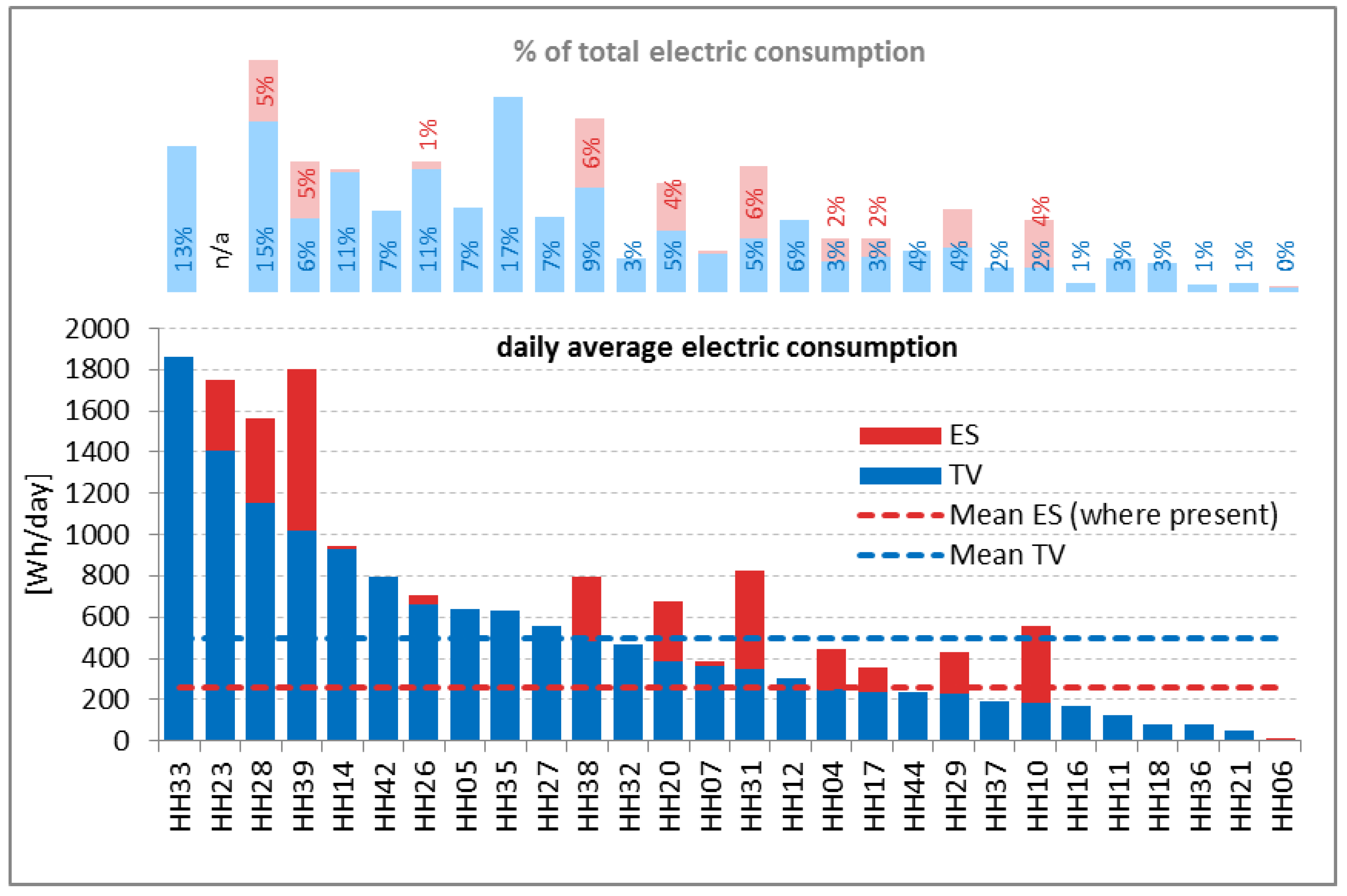
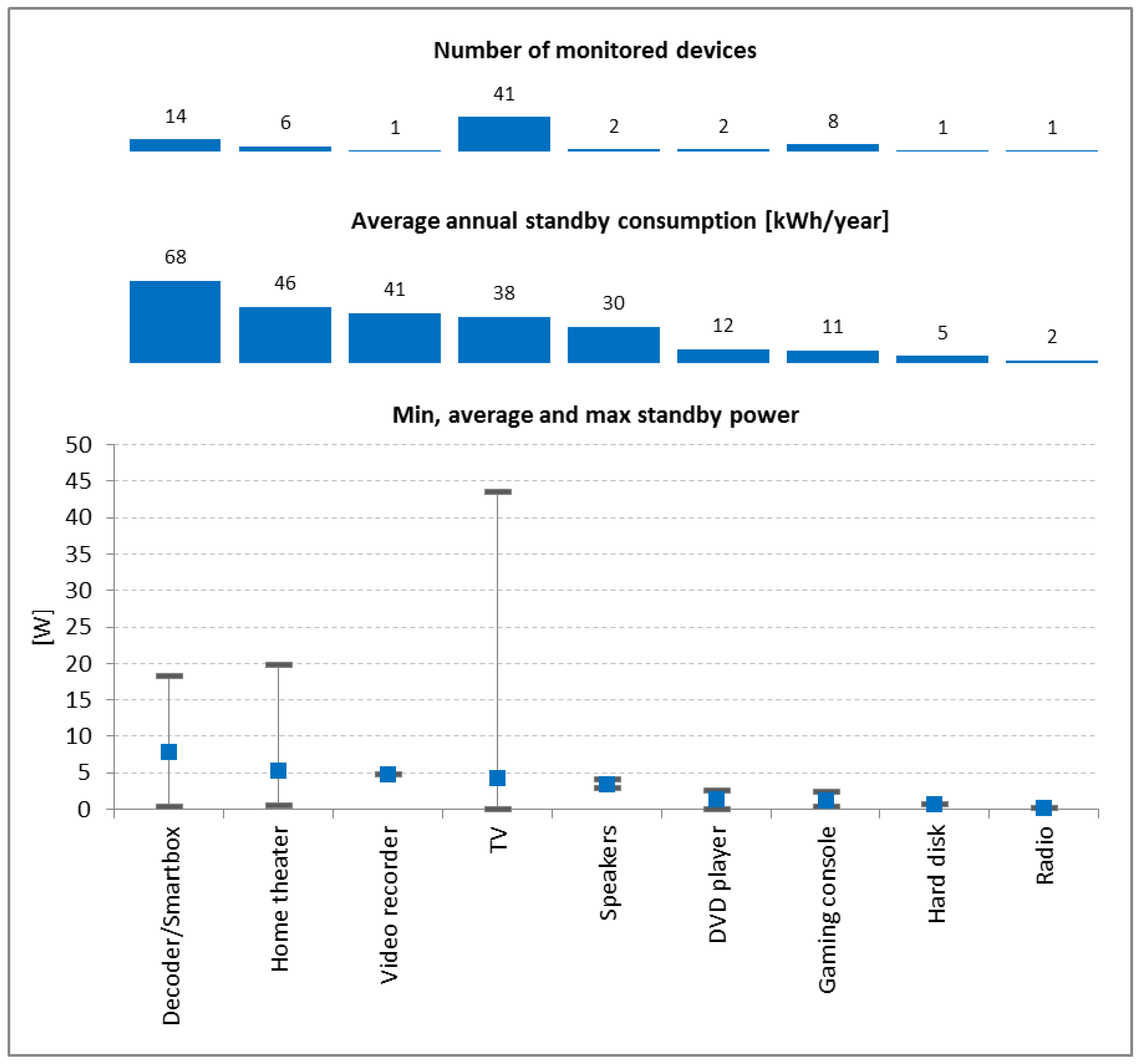
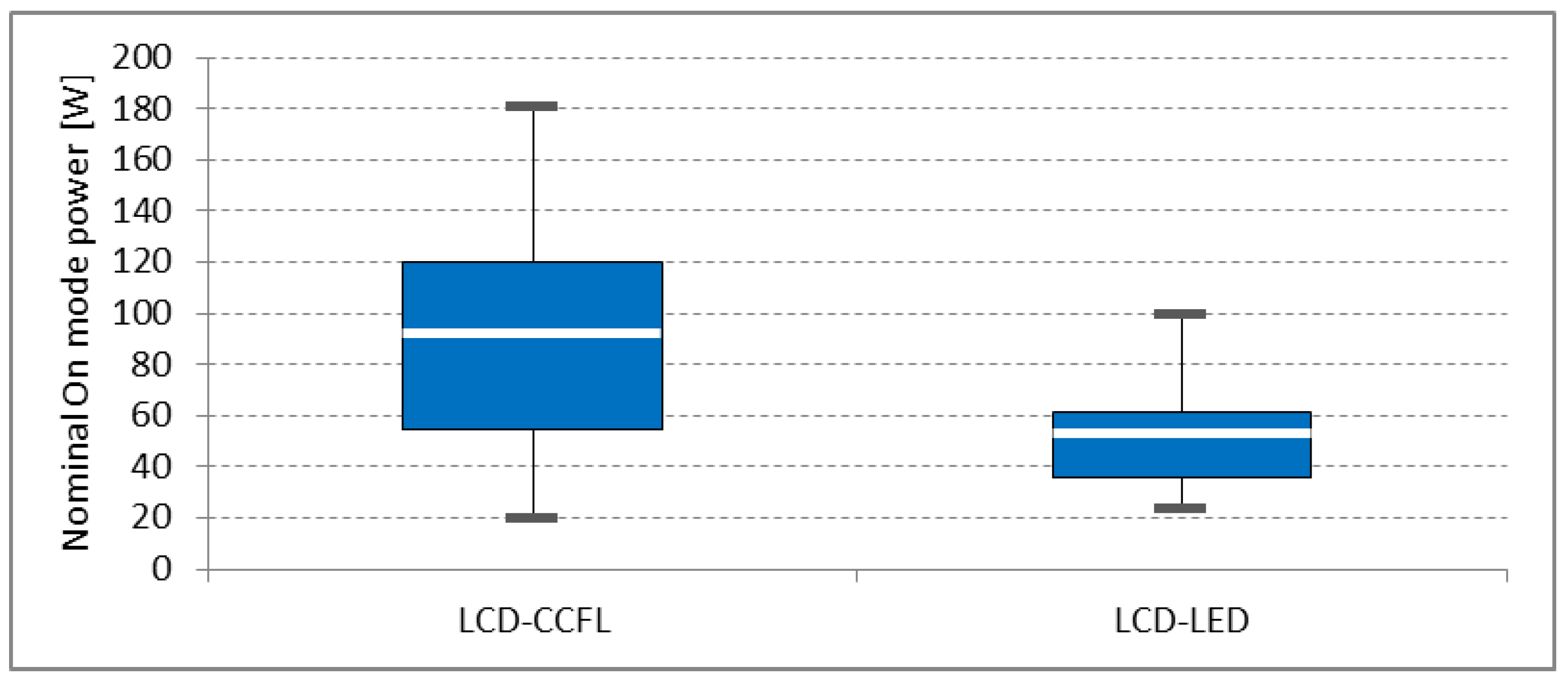
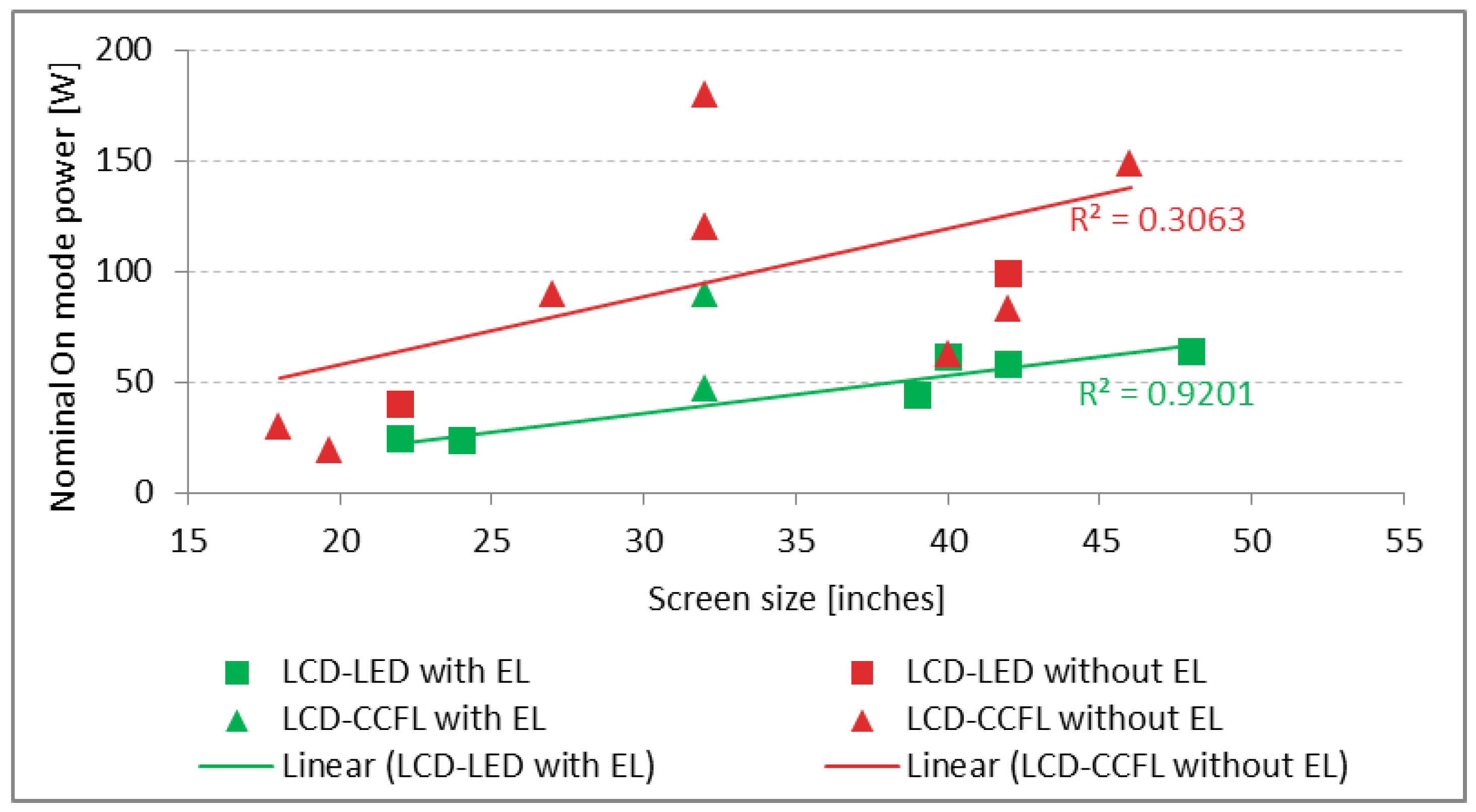
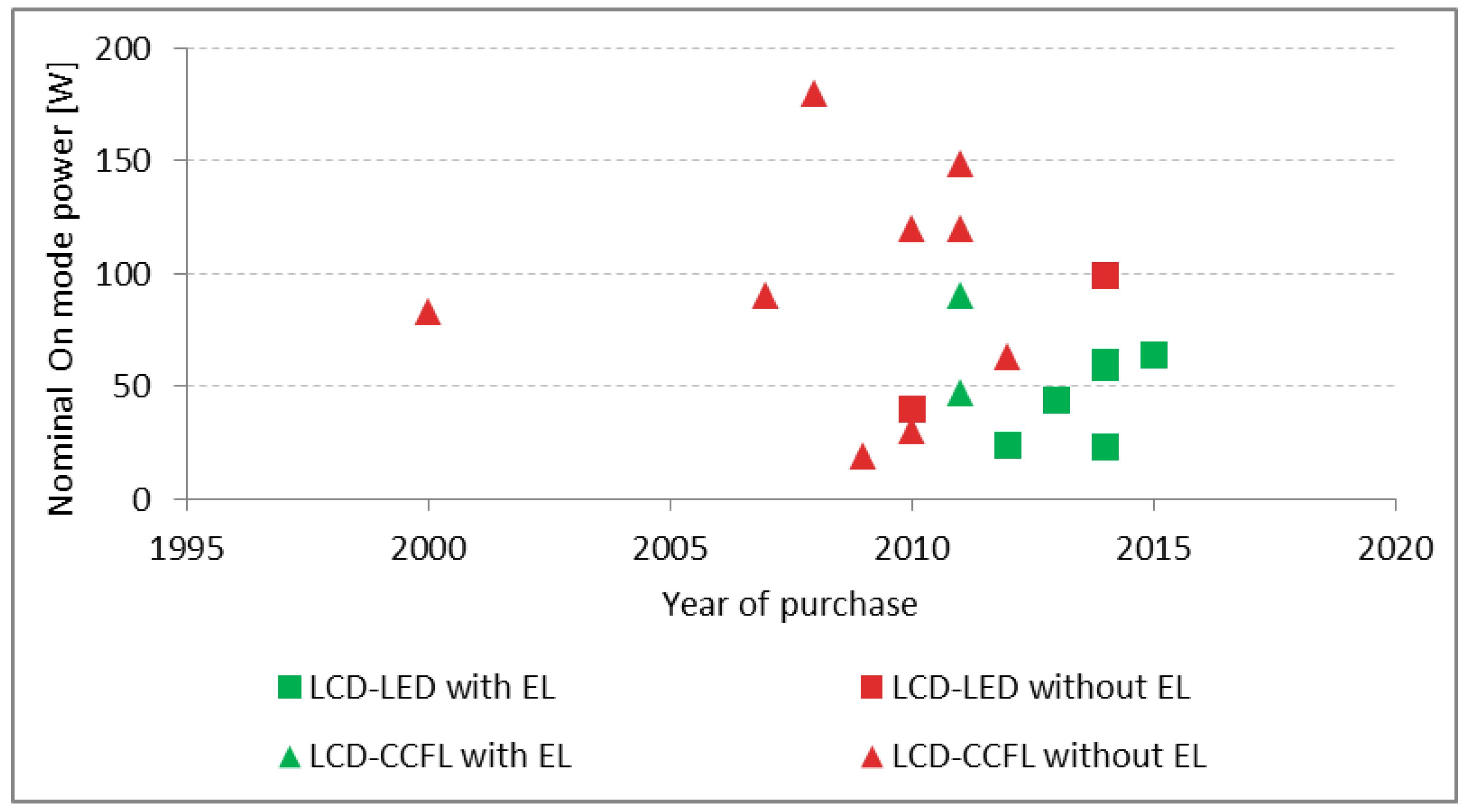
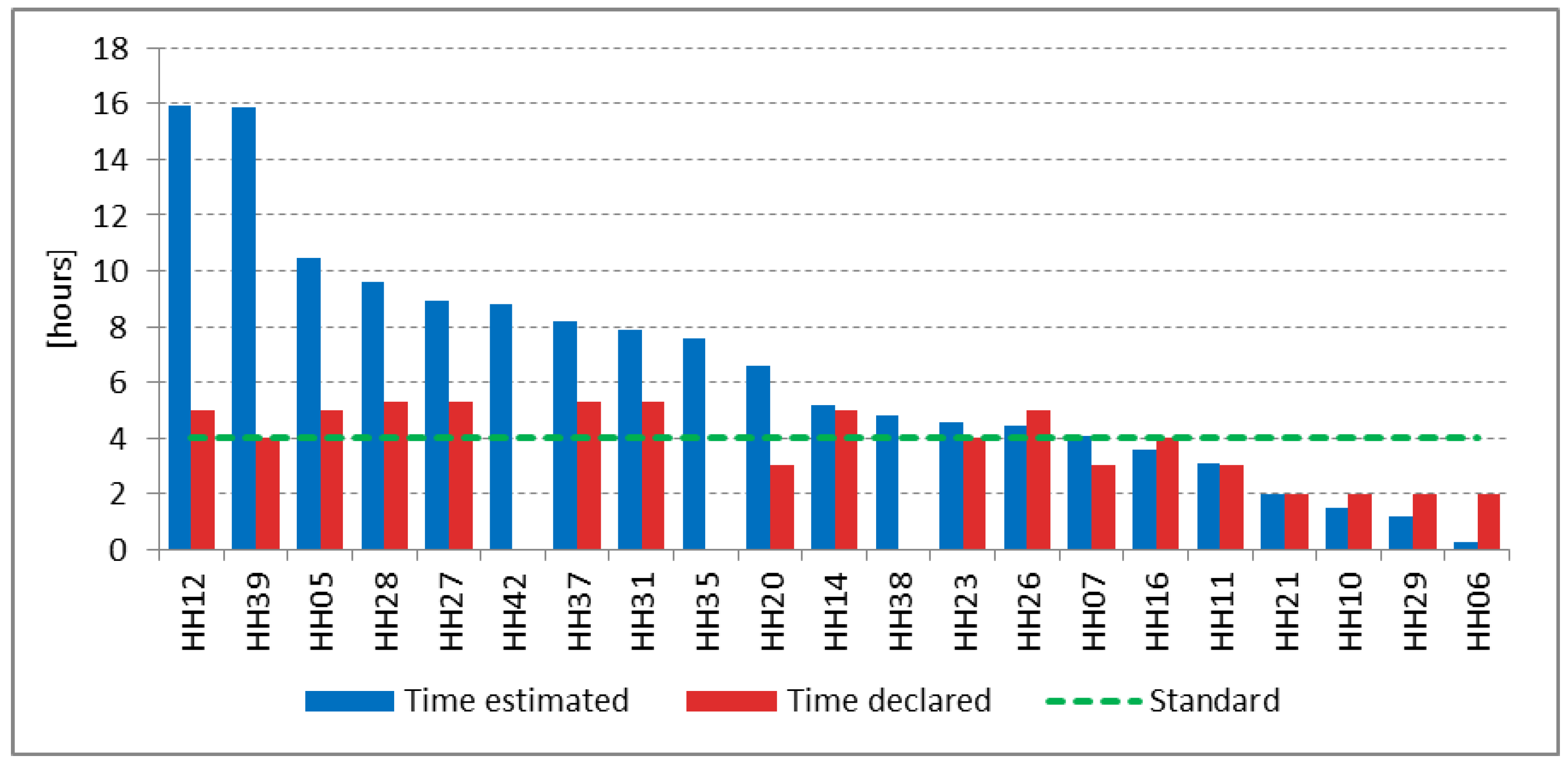
| Geographical Context | Date | Sample Size | Campaign | Reference |
|---|---|---|---|---|
| France | 1995 | 111 | Enertech, Project Ciel | [26] |
| Portugal | 1995 | 25 | CCE | [26] |
| France | 1998 | 20 | Enertech, Project ECODROME | [27] |
| Italy | 2001 | 102 | EERG, Project EURECO | [16] |
| Italy | 2002 | 110 | EERG, Project Micene | [17] |
| Italy | 2009 | 60 | EERG, Project REMODECE | [25] |
| Florida | 2017 | 60 | Florida Solar Energy Center | [19] |
| Massachusetts | 2018 | 350 | Navigant | [21] |
| Household | Location (Province) | Building Type | Main TV Monitored | Standby Monitored | |||
|---|---|---|---|---|---|---|---|
| Technology | Energy Label | TV | ES | Type of ES | |||
| HH04 | Milan | SFH | Unclear | - | 1 | 1 | Gaming console |
| HH05 | Milan | AB | LCD LED | A | 1 | 0 | - |
| HH06 | Milan | AB | LCD CCFL | - | 1 | 0 | - |
| HH07 | Milan | SFH | LCD CCFL | - | 1 | 2 | Decoder/smartbox, gaming console |
| HH10 | Milan | AB | LCD CCFL | - | 1 | 1 | TV, gaming console |
| HH11 | Milan | AB | LCD CCFL | - | 1 | 0 | - |
| HH12 | Milan | AB | LCD CCFL | - | 1 | 1 | Decoder/smartbox |
| HH14 | Milan | SFH | LCD CCFL | - | 1 | 2 | Decoder/smartbox, Home theater |
| HH16 | Milan | AB | LCD CCFL | B | 1 | 1 | DVD player |
| HH17 | Milan | AB | LCD CCFL | - | 1 | 0 | - |
| HH18 | Milan | AB | Unclear | - | 1 | 1 | Decoder/smartbox |
| HH20 | Milan | AB | LCD LED | A | 1 | 1 | Decoder/smartbox |
| HH21 | Varese | AB | LCD LED | A | 2 | 2 | Speakers, Decoder/smartbox |
| HH23 | Varese | SFH | Unclear | - | 3 | 0 | - |
| HH26 | Varese | SFH | LCD CCFL | - | 1 | 2 | Gaming console, radio |
| HH27 | Varese | SFH | LCD CCFL | - | 1 | 0 | - |
| HH28 | Varese | SFH | LCD CCFL | - | 2 | 3 | Satellite decoder, decoder/smartbox, home theater |
| HH29 | Varese | SFH | Plasma | - | 2 | 2 | Home theater, video recorder |
| HH31 | Varese | SFH | LCD LED | A+ | 3 | 4 | Home theater, home theater, decoder/smartbox, gaming console |
| HH32 | Varese | SFH | LCD CCFL | - | 1 | 0 | - |
| HH33 | Varese | AB | unclear | - | 1 | 0 | - |
| HH35 | Varese | SFH | LCD CCFL | - | 1 | 0 | - |
| HH36 | Varese | SFH | LCD CCFL | - | 2 | 1 | DVD player |
| HH37 | Varese | AB | LCD LED | A | 1 | 0 | - |
| HH38 | Varese | AB | LCD LED | - | 1 | 1 | Gaming console |
| HH39 | Varese | SFH | LCD LED | A+ | 4 | 6 | Speakers, home theater, decoder/smartbox, gaming console, decoder/smartbox, gaming console |
| HH42 | Varese | AB | LCD CCFL | B | 0 | - | |
| HH44 | Varese | SFH | CRT | - | 1 | 0 | - |
| HH09 * | Milan | Unclear | - | - | 1 | 1 | Decoder/smartbox |
| HH24 * | Varese | SFH | - | - | 1 | 1 | Decoder/smartbox |
| HH30 * | Varese | SFH | - | - | 1 | 3 | Hard disk, decoder/smartbox, gaming console |
| HH43 * | Varese | Unclear | - | - | 1 | 1 | Decoder/smartbox |
| Data Comparison | EURECO (2001) | MICENE (2003–2004) | REMODECE (2007–2008) | HESCA (2017) | |
|---|---|---|---|---|---|
| Sample size (number of households) | 102 | 110 | 60 | 28 | |
| Annual electric consumption (kWh/year) | Average household | 3157 | 3229 | 3050 | 3139 |
| Average TV | 124 | 122 | 197 | 180 | |
| Average entertainment devices | 70 | 71 | 96 | 94 | |
© 2019 by the authors. Licensee MDPI, Basel, Switzerland. This article is an open access article distributed under the terms and conditions of the Creative Commons Attribution (CC BY) license (http://creativecommons.org/licenses/by/4.0/).
Share and Cite
Ruggieri, G.; Zangheri, P.; Bulgarelli, M.; Pistochini, P. Monitoring a Sample of Main Televisions and Connected Entertainment Systems in Northern Italy. Energies 2019, 12, 1741. https://doi.org/10.3390/en12091741
Ruggieri G, Zangheri P, Bulgarelli M, Pistochini P. Monitoring a Sample of Main Televisions and Connected Entertainment Systems in Northern Italy. Energies. 2019; 12(9):1741. https://doi.org/10.3390/en12091741
Chicago/Turabian StyleRuggieri, Gianluca, Paolo Zangheri, Mattia Bulgarelli, and Patrizia Pistochini. 2019. "Monitoring a Sample of Main Televisions and Connected Entertainment Systems in Northern Italy" Energies 12, no. 9: 1741. https://doi.org/10.3390/en12091741
APA StyleRuggieri, G., Zangheri, P., Bulgarelli, M., & Pistochini, P. (2019). Monitoring a Sample of Main Televisions and Connected Entertainment Systems in Northern Italy. Energies, 12(9), 1741. https://doi.org/10.3390/en12091741





